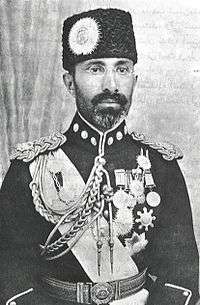Mohammed Nadir Shah
| Mohammed Nadir Shah محمد نادر شاه | |
|---|---|
| King of the God granted Kingdom of Afghanistan and its dependencies[1] | |
 | |
| King of Afghanistan | |
| Reign | 16 October 1929 – 8 November 1933 |
| Predecessor | Habibullah Kalakāni |
| Successor | Mohammed Zahir Shah |
| Born |
9 April 1883 Dehra Dun, British India |
| Died |
8 November 1933 (aged 50) Kabul, Afghanistan |
| Spouse | Mah Parwar Begum |
| House | Barakzai |
| Father | Mohammed Yusuf Khan |
| Mother | Sharaf Sultana Hukumat Begum |
| Religion | Sunni Islam |
Mohammed Nadir Shah (Pashto: محمد نادر شاه, Urdu: محمد نادر شاه – born Mohammed Nadir Khan; 9 April 1883 – 8 November 1933) was King of Afghanistan from 15 October 1929 until his assassination in November 1933. Previously, he served as Minister of War, Afghan Ambassador to France, and as a general in the military of Afghanistan. He and his son Mohammed Zahir Shah, who succeeded him, are sometimes referred to as the Musahiban.
Background
Nadir Khan was born on 9 April 1883 in Dehra Dun, British India, into the Telai branch of the then Royal dynasty of Afghanistan (of the Mohammadzai section of Barakzai Pashtuns). His father was Mohammad Yusuf Khan and his mother was Sharaf Sultana, a Punjabi. His paternal grandfather was Yahya Khan and his great grandfather was Sultan Muhammad Khan Telai, the brother of Dost Mohammed Khan. Sultan Mohammad Khan Telai was his grandfather.
Rise to power
After growing up in India, Nadir Khan first went to Afghanistan when his grandfather Mohammad Yahya was authorized to return from exile by the British and Abdur Rahman Khan.[2] He later became a general under King Amanullah Khan and led the Afghan National Army in the Third Anglo-Afghan War. After the war, Nadir Khan was made Minister of War and Afghan Ambassador to France.
Shortly after a rebellion by some Pashtun tribesmen and Tajik forces of Habibullah Kalakani against the monarchy, Nadir Khan was exiled due to disagreements with King Amanullah. After the overthrow of Amanullah Khan's monarchy by Habibullah Kalakani, he returned to Afghanistan with his Afghan army and took most of Afghanistan. By 13 October 1929, Nadir Khan captured Kabul and subsequently sacked the city.[3] He captured Kalakani and executed him by hanging on 1 November 1929, along with some of the members of his inner circle.
King of Afghanistan
As Shah of Afghanistan Nadir Khan quickly abolished most of Amanullah Khan's reforms, but despite his efforts to rebuild an army that had just been engaged in suppressing a rebellion, the forces remained weak while the religious and tribal leaders grew strong. In 1930, there were uprisings by the Shinwari tribes of the east as well as by Tajiks of Kabul province and north of Kabul. The same year, a Soviet force crossed the border in pursuit of an Uzbek leader whose forces had been harassing the Soviets from his sanctuary in Afghanistan. He was driven back to the Soviet side by the Afghan army in April 1930, and by the end of 1931 most uprisings had been subdued.
Nadir Khan named a ten-member cabinet, consisting mostly of members of his family, and in September 1930 he called into session a loya jirga of 286 which confirmed his accession to the throne. In 1931, the King promulgated a new constitution. Despite its appearance as a constitutional monarchy, the document effectively instituted a Royal oligarchy, and popular participation was merely an illusion.
Although Nadir Khan placated religious factions with a constitutional emphasis on orthodox denominational principles, he also took steps to modernize Afghanistan in material ways, although far less obtrusively than Amanullah. He improved road construction, especially the Great North Road through the Hindu Kush, methods of communication, and helped establish Afghanistan's first university in 1931; however, this university (Kabul University) did not admit any students until 1932.[4] He forged commercial links with the same foreign powers that Amanullah had established diplomatic relations with in the 1920s, and, under the leadership of several prominent entrepreneurs, he initiated a banking system and long-range economic planning. Although his efforts to improve the army did not bear fruit immediately, by the time of his death in 1933 Nadir Shah had created a 40,000-strong military force.
Assassination
On 8 November 1933, Nadir Khan was visiting a high school and was shot to death by Abdul Khaliq during a graduation ceremony.[5] An ethnic Hazara, Abdul Khaliq was immediately apprehended and later executed after being tortured.[6] According to Hafizullah Emadi, "The government arrested Abdul Khaliq, his family, and friends, and used this opportunity to arrest other potential rivals and execute them on charges of plotting the assassination of King Nadir." [7]
Ancestry
| Ancestors of Mohammed Nadir Shah | ||||||||||||||||||||||||||||||||||||||||||||||||||||||||||||||||||||||||||||||||||||||||||||||||||||||||||||||||||||||||||||||||||||||||||||||||||||||||||||||||||||||||||||||||||||||||||||||||||||||||||||||||||||||||||||||||||||||||||||||||||||||||||||||||||||||||||||||||||||||||||||||||||||||||||||||||||||||||||||||||||||||||||||||||||||||||||||||||||||||||||||||||||
|---|---|---|---|---|---|---|---|---|---|---|---|---|---|---|---|---|---|---|---|---|---|---|---|---|---|---|---|---|---|---|---|---|---|---|---|---|---|---|---|---|---|---|---|---|---|---|---|---|---|---|---|---|---|---|---|---|---|---|---|---|---|---|---|---|---|---|---|---|---|---|---|---|---|---|---|---|---|---|---|---|---|---|---|---|---|---|---|---|---|---|---|---|---|---|---|---|---|---|---|---|---|---|---|---|---|---|---|---|---|---|---|---|---|---|---|---|---|---|---|---|---|---|---|---|---|---|---|---|---|---|---|---|---|---|---|---|---|---|---|---|---|---|---|---|---|---|---|---|---|---|---|---|---|---|---|---|---|---|---|---|---|---|---|---|---|---|---|---|---|---|---|---|---|---|---|---|---|---|---|---|---|---|---|---|---|---|---|---|---|---|---|---|---|---|---|---|---|---|---|---|---|---|---|---|---|---|---|---|---|---|---|---|---|---|---|---|---|---|---|---|---|---|---|---|---|---|---|---|---|---|---|---|---|---|---|---|---|---|---|---|---|---|---|---|---|---|---|---|---|---|---|---|---|---|---|---|---|---|---|---|---|---|---|---|---|---|---|---|---|---|---|---|---|---|---|---|---|---|---|---|---|---|---|---|---|---|---|---|---|---|---|---|---|---|---|---|---|---|---|---|---|---|---|---|---|---|---|---|---|---|---|---|---|---|---|---|---|---|---|---|---|---|---|---|---|---|---|---|---|---|---|---|---|---|---|---|---|---|---|---|---|---|---|---|---|---|---|---|---|---|---|---|---|---|---|---|---|---|---|---|---|---|---|---|---|---|---|---|---|---|
| ||||||||||||||||||||||||||||||||||||||||||||||||||||||||||||||||||||||||||||||||||||||||||||||||||||||||||||||||||||||||||||||||||||||||||||||||||||||||||||||||||||||||||||||||||||||||||||||||||||||||||||||||||||||||||||||||||||||||||||||||||||||||||||||||||||||||||||||||||||||||||||||||||||||||||||||||||||||||||||||||||||||||||||||||||||||||||||||||||||||||||||||||||
See also
References and footnotes
- ↑ Royal Ark
- ↑ Schinasi, May (7 April 2008). "MOḤAMMAD NĀDER SHAH". Encyclopædia Iranica (Online ed.). United States: Columbia University.
- ↑ Balland, D. "AFGHĀNISTĀN". In Ehsan Yarshater. Encyclopædia Iranica (Online ed.). United States: Columbia University. Retrieved 2008.
- ↑ Kabul University web page: History History
- ↑ Dupree, Louis: "Afghanistan", page 474. Princeton University Press, 1973
- ↑ Runion, Meredith (October 2007). The History of Afghanistan. Greenwood. p. 93. ISBN 978-0-313-33798-7.
- ↑ Emadi, Hafizullah (2001). Politics of the Dispossessed: Superpowers and Developments in the Middle East. Greenwood Publishing Group. p. 24. ISBN 0-2759-7365-4.
- ↑ Royal Ark
External links
| Wikimedia Commons has media related to Mohammed Nadir Khan. |
| Mohammed Nadir Shah Born: 10 April 1880 Died: 8 November 1933 | ||
| Regnal titles | ||
|---|---|---|
| Preceded by Habibullah Ghazi Emir of Afghanistan |
King of Afghanistan 1929–1933 |
Succeeded by Mohammed Zahir Shah |
| ||||||||||||||||||||||||||||||||||
|